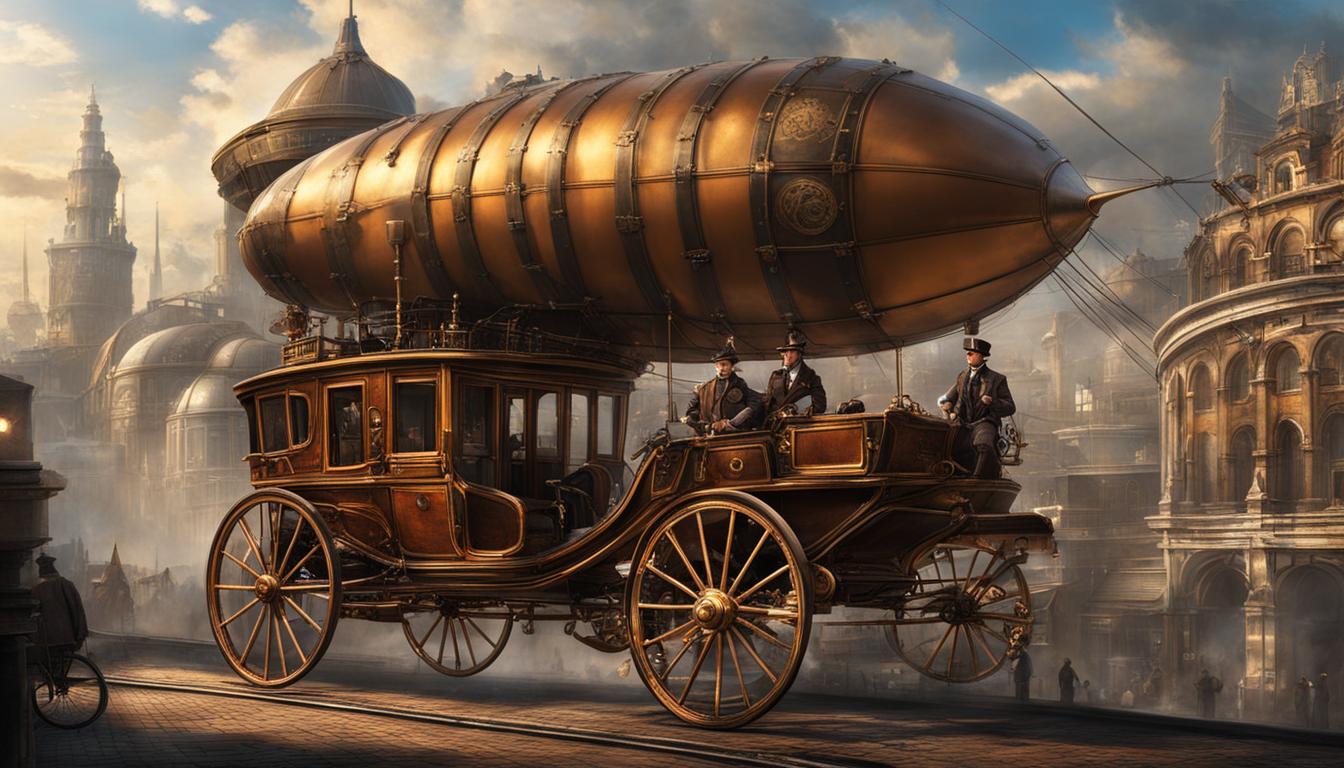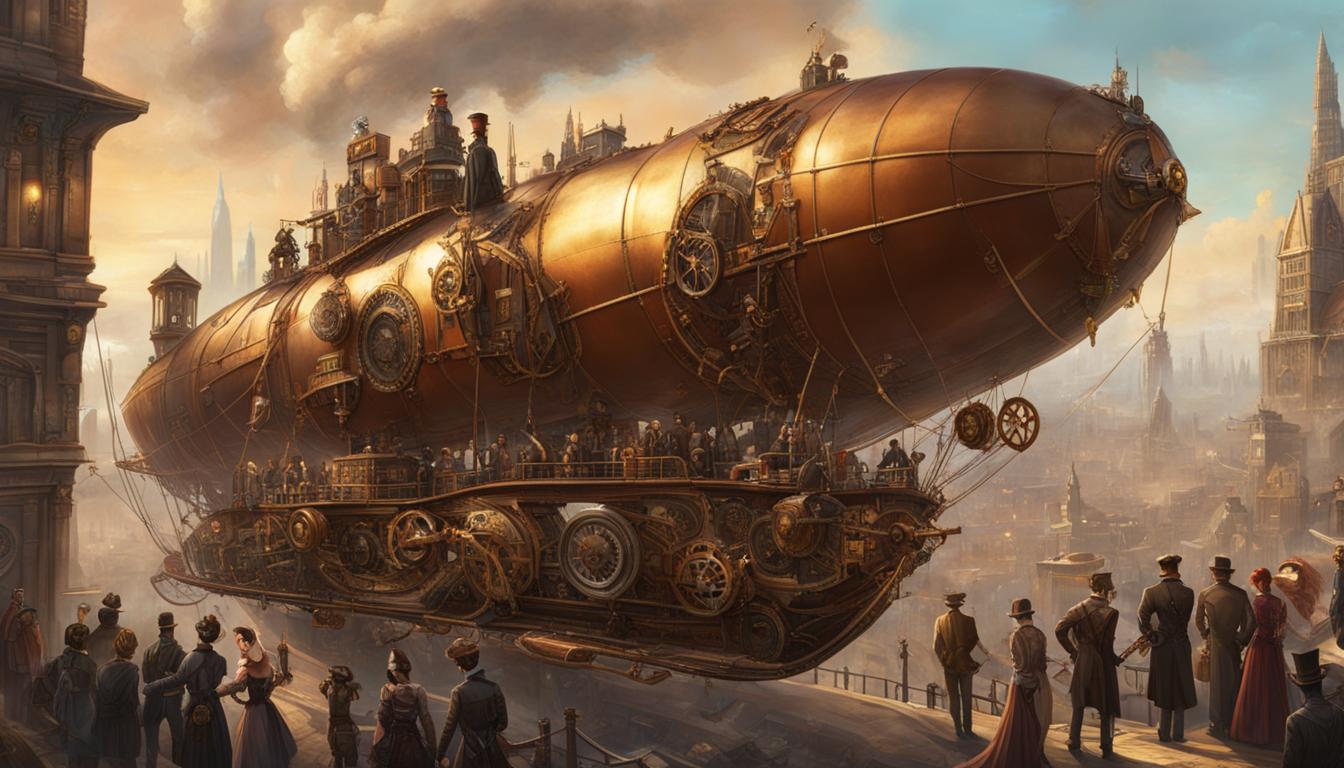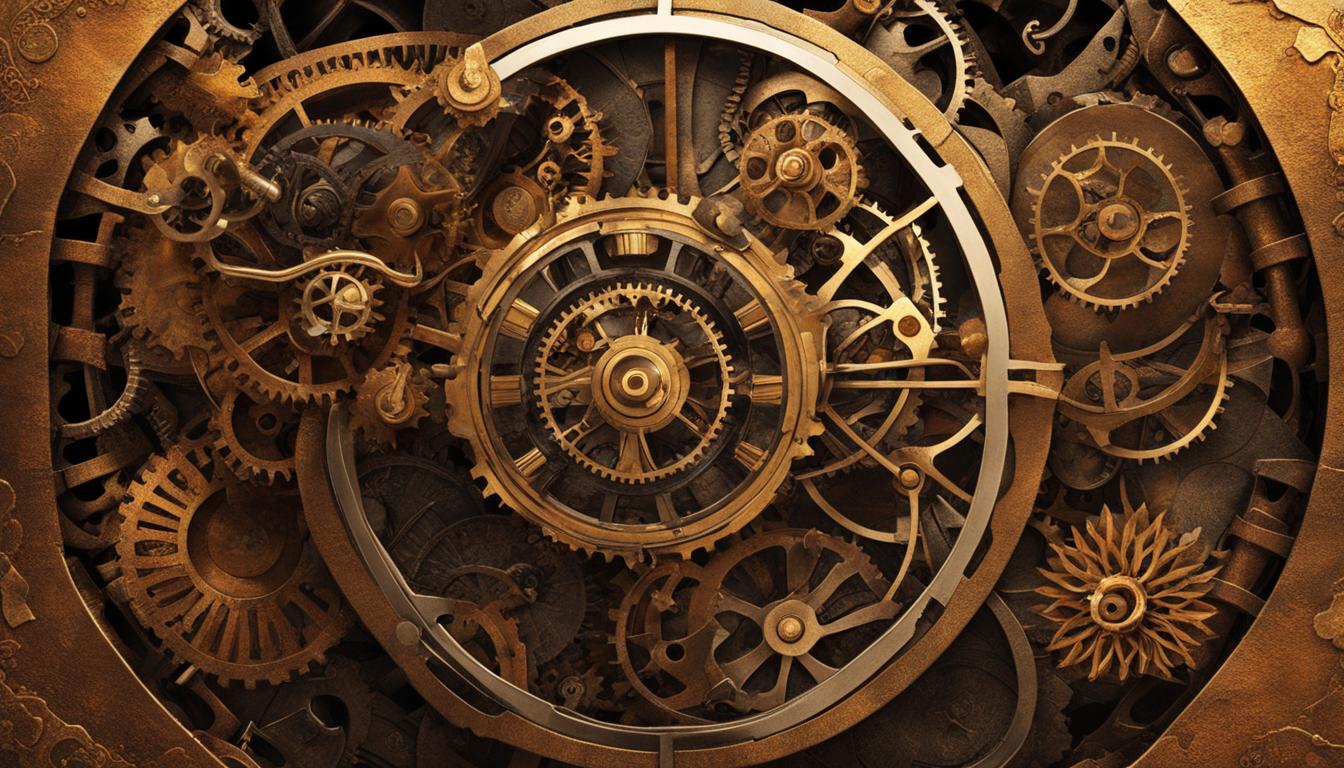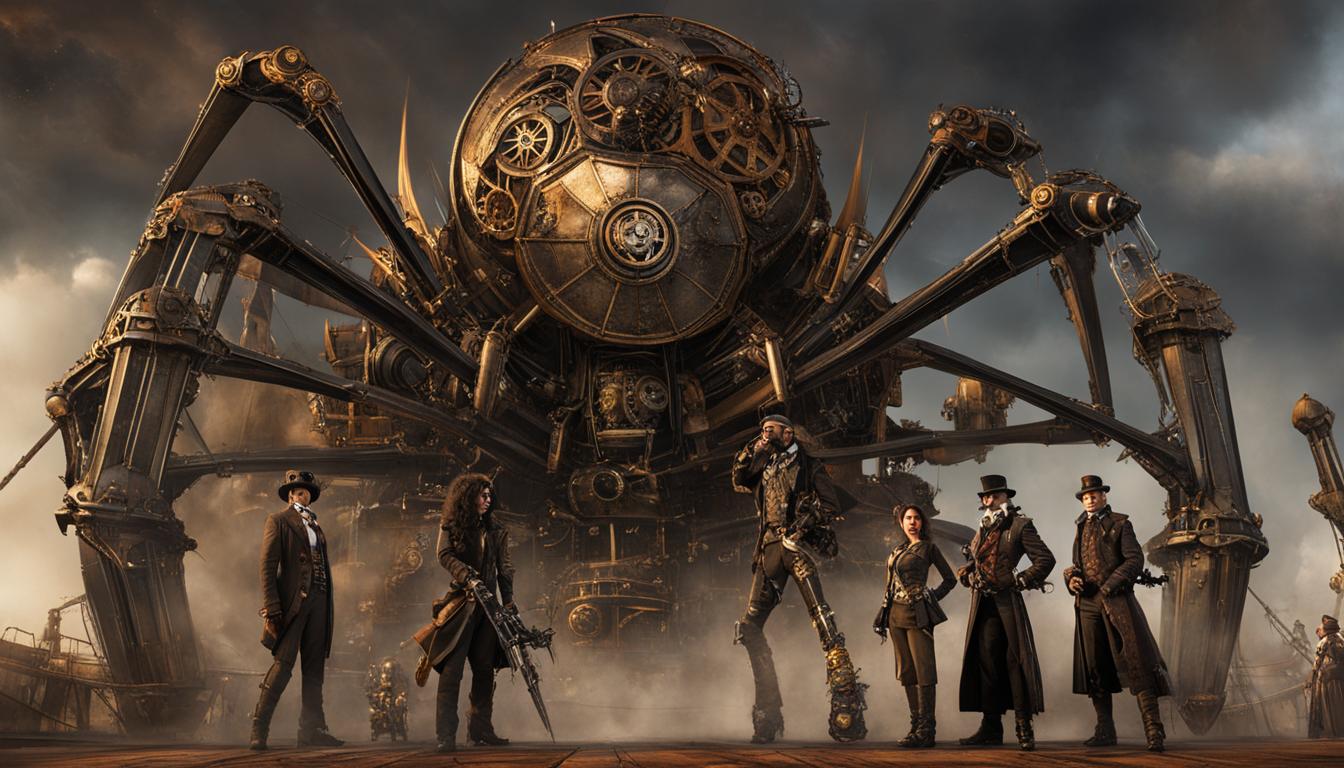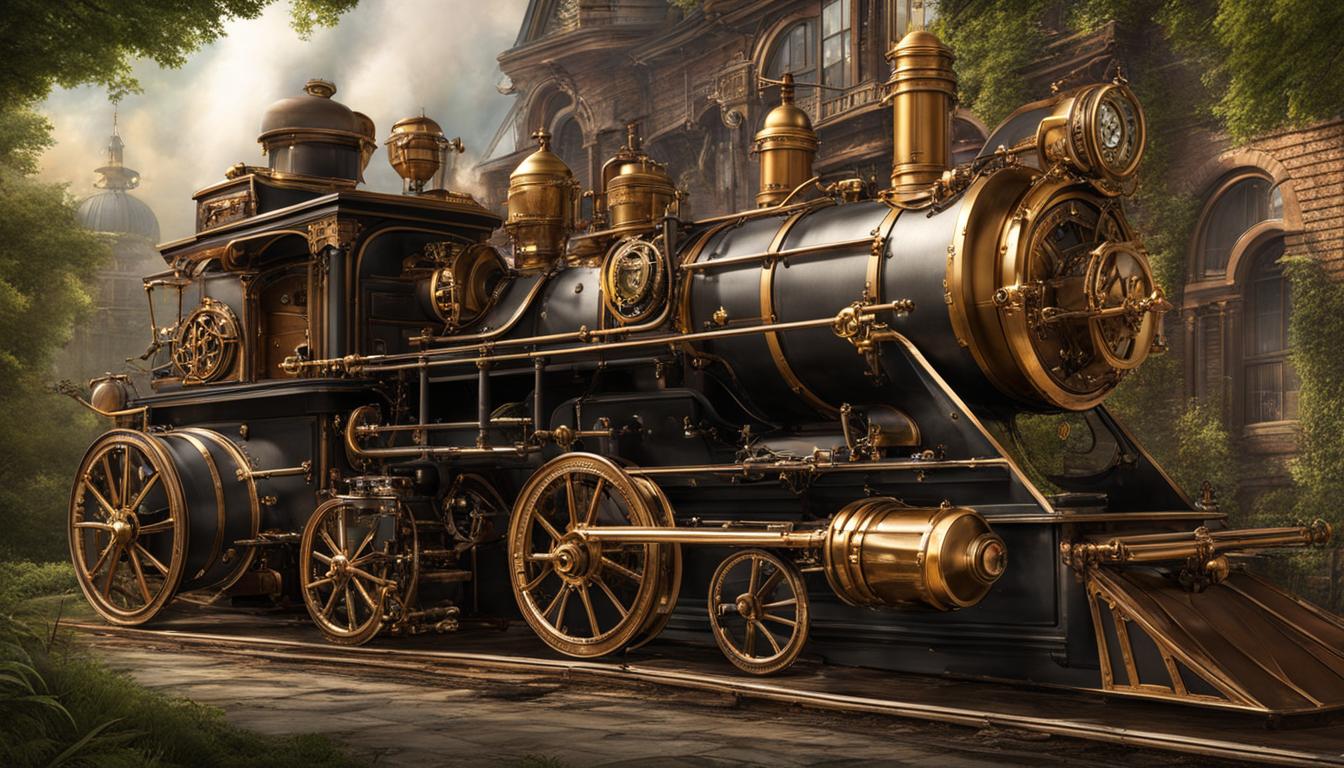Steampunk, a design movement and aesthetic that emerged in the mid-2000s, offers a unique perspective on historical milestones and societal progress. Inspired by the literature of writers like Jules Verne and Michael Moorcock, steampunk embraces a retro-Victorian aesthetic and reimagines a world where technology is powered by steam and gears. Although its popularity has declined in recent years, steampunk’s influence can still be seen in various movements and narratives, addressing historical breakthroughs and societal advancements.
Key Takeaways:
- Steampunk offers a unique perspective on historical progress and societal evolution.
- Inspired by retro-Victorian aesthetics, steampunk reimagines a world powered by steam and gears.
- The decline of steampunk coincided with the rise of smartphones and increasing complexity of technology.
- Steampunk’s influence can still be observed in movements like the Right to Repair.
- Research plays a vital role in crafting believable and immersive steampunk stories.
The Victorian Era and the Industrial Revolution: Steampunk’s Historical Context
Steampunk is firmly rooted in the historical context of the Victorian era and the Industrial Revolution. The Victorian era, named after Queen Victoria’s reign from 1837 to 1901, was a time of great societal contrasts, technological advancements, and scientific exploration. It was during this period that the Industrial Revolution brought about a significant shift from agrarian societies to urban industrial landscapes.
The Industrial Revolution marked a time of transformative societal changes. Steam-powered machinery revolutionized the way people worked and lived, leading to the development of factories and mass production. The invention of steam engines and the expansion of railroads transformed transportation and facilitated the growth of cities. As a result, urban centers expanded rapidly, and new social structures emerged.
In the context of this historical backdrop, steampunk authors draw inspiration from these elements and reimagine them in a world where steam technology has led to even more advanced and fantastical inventions. The juxtaposition of Victorian sensibilities with futuristic machinery forms the core aesthetic of steampunk and provides a rich backdrop for storytelling.
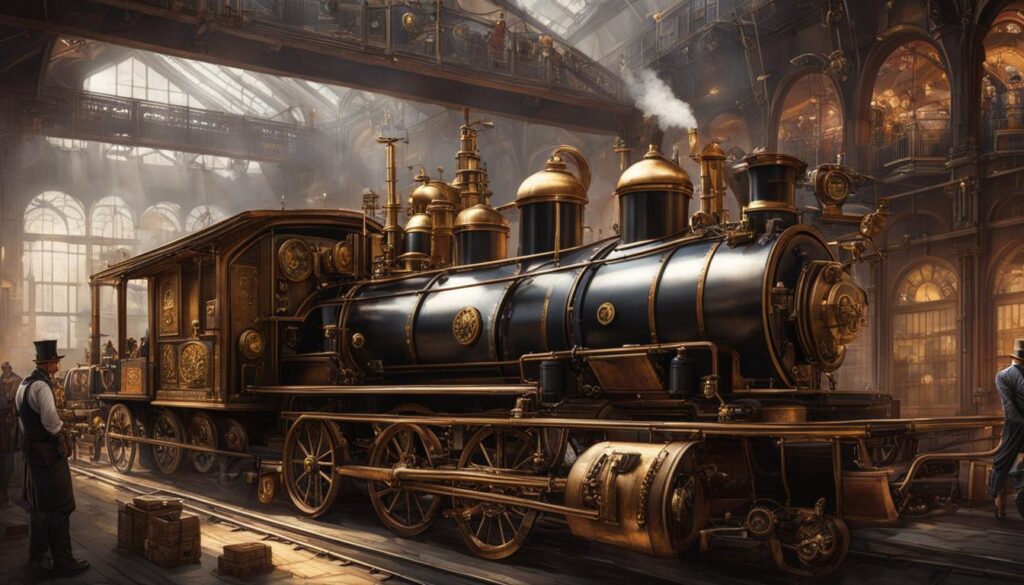
| Key Aspects | Victorian Era | Industrial Revolution |
|---|---|---|
| Societal Shifts | A transition from agrarian societies to urban industrial landscapes. | An era of rapid industrialization and technological advancements. |
| Technological Advancements | Scientific exploration, advances in engineering, and the rise of the steam engine. | Industrial machinery, steam-powered engines, and the development of factories. |
| Impact on Society | Emergence of new social structures, changes in class dynamics, and evolving gender roles. | Transformation of work and living conditions, and the growth of cities. |
Steampunk’s Imaginative Twist
Steampunk takes these historical elements and adds an imaginative twist, pushing the boundaries of what could have been. It envisions a world where steam-powered machinery is at the forefront of innovation, driving even more advanced technological developments. The genre combines the awe-inspiring wonders of the Victorian era with the fantastical possibilities of alternative histories, resulting in a distinct aesthetic and storytelling style that continues to captivate audiences today.
Themes in Steampunk: Rebellion, Innovation, and Social Reform
Steampunk goes beyond its captivating aesthetic and delves into thought-provoking themes that challenge societal norms and examine the human desire for rebellion, innovation, and social reform. In the realm of rebellion, steampunk narratives often feature characters who defy conventional norms and rebel against oppressive regimes, echoing the socio-political unrest of the Victorian era. These stories inspire readers to question authority and embrace individuality, reminding us that change often comes from those who dare to challenge the status quo.
Innovation is another theme that permeates the steampunk genre. Steampunk authors celebrate the curiosity and ingenuity of inventors, pushing the boundaries of what is possible in a world powered by steam. The intricate machinery and fantastical inventions showcased in steampunk stories spark the imagination and encourage readers to explore the limitless potential of human innovation and technological advancement.
“Steampunk is a genre that allows us to reimagine history, explore ‘what if’ scenarios, and confront contemporary issues through the lens of the past. It’s a celebration of rebellion, innovation, and social reform,” says renowned steampunk author, Amelia Tesla.
Finally, social reform is a crucial theme that steampunk narratives tackle. By reflecting on the social disparities, gender roles, and workers’ rights struggles of the Victorian era, steampunk authors shed light on enduring social issues and inspire readers to consider the significance of reform and equality. Through these themes, steampunk literature prompts us to reflect on our own society and contemplate the changes we can make to shape a better future.
| Themes in Steampunk | |
|---|---|
| Rebellion | Characters challenging conventional norms and defying oppressive regimes. |
| Innovation | Celebrating the fascination with invention and technological advancement. |
| Social Reform | Reflecting social disparities, gender roles, and workers’ rights struggles. |
Notable Works in Steampunk: Exploring the Imagination of the Victorian Era
Steampunk has produced a plethora of notable works that delve into the captivating subgenre, blending history and fiction to create imaginative and thought-provoking narratives. These works showcase the diverse range of storytelling that can be found within the steampunk genre, captivating readers with their unique blend of Victorian aesthetics and futuristic inventions.
One such notable work is “The Difference Engine” by William Gibson and Bruce Sterling. This novel presents an alternate history where Charles Babbage’s mechanical computers became a reality, shaping the course of technological development in the 19th century. It weaves together elements of real historical figures and events with imaginative storytelling, providing a captivating perspective on how the world could have been.
Another standout work is “Mortal Engines” by Philip Reeve, set in a post-apocalyptic future where entire cities are mounted on wheels. This novel combines elements of steampunk with adventure and social commentary, exploring themes of power, survival, and the consequences of technological advancement. It offers readers a unique and immersive glimpse into a world driven by steam-powered machinery.
“Boneshaker” by Cherie Priest is another remarkable work within the steampunk genre. This novel takes readers on a thrilling journey through a world where the gold rush fever collides with a zombie apocalypse and steampunk engineering. With its vivid descriptions and engaging storytelling, “Boneshaker” captures the essence of steampunk’s blending of history and fiction.
China Miéville’s “Perdido Street Station” is also worth mentioning, known for its mesmerizing blend of industrialized magic, socio-political themes, and intricate world-building. Miéville’s imaginative storytelling transports readers to a city filled with fantastical creatures, steam-powered technologies, and a richly detailed Victorian-inspired setting.
Finally, the young adult novel “Airborn” by Kenneth Oppel offers readers a thrilling tale of airships and high-flying adventure. This book combines elements of steampunk aesthetics with a coming-of-age story, capturing the wonder and excitement of exploration within a world where airships rule the skies.
| Notable Works in Steampunk | Author | Setting |
|---|---|---|
| “The Difference Engine” | William Gibson and Bruce Sterling | Alternate history |
| “Mortal Engines” | Philip Reeve | Post-apocalyptic future |
| “Boneshaker” | Cherie Priest | Gold rush-era zombie apocalypse |
| “Perdido Street Station” | China Miéville | Fantasy city with industrialized magic |
| “Airborn” | Kenneth Oppel | Adventure on airships |
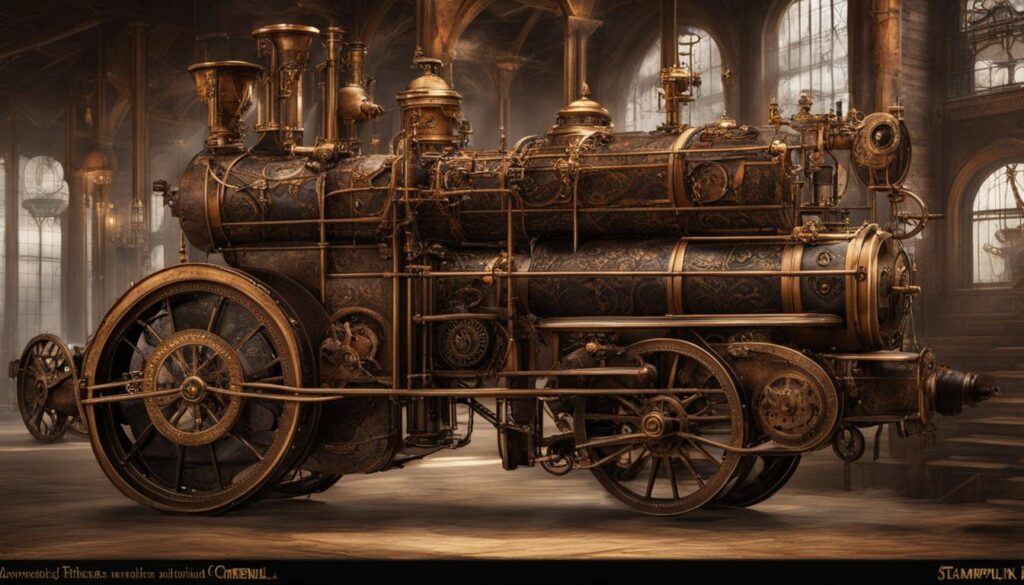
These notable works in steampunk exemplify the genre’s ability to transport readers to fantastical worlds that blend history and fiction, capturing the essence of the Victorian era’s imagination. Through their imaginative storytelling, they invite readers on thrilling adventures, challenge societal norms, and explore the endless possibilities of both steam-powered machinery and the human spirit.
The Importance of Research in Crafting Steampunk Stories
Research is a fundamental aspect of crafting believable and immersive steampunk stories. To achieve historical authenticity, it is vital to have a deep understanding of the Victorian era and the technology of the time. This knowledge lends credibility to the narrative and allows for the creation of intricate and realistic steampunk inventions.
Exploring the social context of the 19th century is equally important. Understanding the class distinctions, gender roles, and political ideologies of the time adds depth to characters and plotlines. By incorporating these societal elements, steampunk narratives can tackle relevant themes and provide thought-provoking commentary on our own society.
Moreover, research enables the creation of convincing alternative histories within the steampunk genre. By blending historical events with fictional elements, authors can explore intriguing “what-if” scenarios and craft captivating stories. Drawing inspiration from existing works in the steampunk subgenre and other literary influences can also provide valuable insights and guidance in the creative process.
| Research in Steampunk | Benefits |
|---|---|
| Historical Authenticity | Creates credibility and realism in the narrative |
| Social Context | Allows for meaningful exploration of societal themes |
| Alternative Histories | Enables intriguing “what-if” scenarios |
| Literary Influences | Provides inspiration and guidance in the creative process |
Quote:
“Research is the key that unlocks the door to a believable and captivating steampunk world. Embrace the historical intricacies, the technological innovations, and the social dynamics of the Victorian era. Let your imagination soar as you blend the lines between history and fiction, crafting a narrative that will transport readers to a world powered by steam and driven by innovation.”
In summary, research is integral to the creative process of writing steampunk stories. It ensures historical accuracy, enhances the richness of the storytelling, and opens the door to endless possibilities. By conducting thorough research, authors can bring the captivating world of steampunk to life, captivating readers with its authenticity and imaginative exploration.
Conclusion
Steampunk, with its fusion of history and fiction, has left an enduring legacy and continues to exert its influence on art, literature, fashion, and imagination. Although its popularity may have waned in recent years, the essence of steampunk can still be felt in various movements, such as the Right to Repair, where transparency and repairability in consumer electronics are advocated.
Steampunk’s exploration of rebellion, innovation, and social reform resonates with audiences, prompting us to question societal norms and embrace the potential for change. Its imaginative storytelling captivates the imagination and inspires creativity, reminding us of the importance of challenging the status quo and striving for a better future.
As we navigate the complexities of the modern world, steampunk’s ethos serves as a timeless reminder to seek progress, celebrate innovation, and question the boundaries of what is possible. Steeped in a unique aesthetic and timeless themes, steampunk’s enduring influence continues to shape our perception of history and inspire us to imagine new possibilities.
FAQ
What is steampunk?
Steampunk is a design movement and aesthetic that emerged in the mid-2000s. It combines a retro-Victorian aesthetic with a world where technology is powered by steam and gears instead of electricity and silicon.
What inspired the steampunk movement?
Steampunk was inspired by the literature of writers like Jules Verne and Michael Moorcock, who imagined a world where steam technology led to advanced and fantastical inventions.
Why did steampunk decline in popularity?
The decline of steampunk coincided with the rise of smartphones and the increasing complexity of technology. Many believe that the sleek design and inscrutable inner workings of the iPhone played a significant role in its decline.
What themes does steampunk explore?
Steampunk explores themes of rebellion, innovation, and social reform. It challenges societal norms, celebrates invention and technological advancement, and addresses issues such as class disparities, gender roles, and workers’ rights.
Can you recommend any notable works in steampunk?
Some notable works in steampunk include “The Difference Engine” by William Gibson and Bruce Sterling, “Mortal Engines” by Philip Reeve, “Boneshaker” by Cherie Priest, “Perdido Street Station” by China Miéville, and “Airborn” by Kenneth Oppel.
How important is research in writing steampunk?
Research is vital in crafting a believable and immersive steampunk story. It ensures historical authenticity, guides the creation of steampunk inventions, adds depth to characters and plotlines, and allows for the analysis of existing works for inspiration.
What is the legacy of steampunk?
While the popularity of steampunk may have declined, its influence can still be seen in movements like the Right to Repair, which advocates for transparency and repairability in consumer electronics. Steampunk’s fusion of history and fiction, exploration of themes, and imaginative storytelling continue to inspire creativity.

